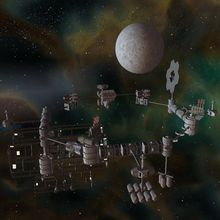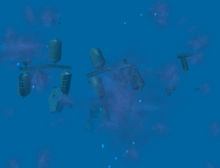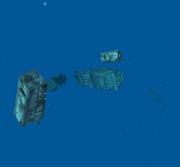
|
This wiki is closed in favour of the new wiki. Information shown is likely to be very out of date. |
History of Rheinland
The history of Rheinland begins with the arrival of it's sleeper ship in Sirius in the year 2 A.S. The landing occured in the southern clearing of the sector, inbetween the Walker and Crow nebulae, with the location picked specifically for the natural resources it offered. Securing several systems in the space of a few centuries, it's government would quickly attempt conquest by declaring war on the Gas Miners Guild in 589 A.S. and sending it's military into Sigma-13. The push was unsuccessful however, and ended in the country descending into chaos at the dawn of 672 A.S., the date of the Popular Revolution.
The Federal Republic would be formally recognised in 673 A.S., and would slowly descend back into military dictatorship over the following years, up until the Nomad War of 800 A.S. After the destruction of the infested Rheinland fleet that attacked Kusari, the house would finally begin rebuilding. The new, liberal Chancellor Steller would push Rheinland into a period of increased growth, at the cost of increasing corporate influence in the government. In 810 A.S. Chancellor Reinhardt's term in office would begin, marking the first increases in military funding since the end of the Nomad infestation, as well as a new period of tensions with Liberty.
Early history
Escape from Sol

The period of the century before 0 A.S. (2100-2200 A.D.) was dominated by the war between the Alliance, composed out of western nations of the earth, and the Coalition, created by the east. After a century of brutal warfare, the conflict eventually tipped in favour of the Coalition, when their forces successfully conquered the planet Mars. As a last ditch effort, the Alliance had activated five sleeper ships constructed for escape purposes in the event of a Coalition victory, each of the ships carrying people from a single nation, and named by the people who built it. The German ship was christened as the Rheinland.
In 0 A.S. (2200 A.D.) the Coalition push reached Jupiter, and the Alliance sleeper ships were launched from the surface of Titan, straight into a full blown Coalition blockade. During the breakthrough, three of the ships (French, Italian and Australian) were heavily damaged, and presumably lost. Five managed to escape: the Kusari, the Bretonia, the Hispania, the Liberty and the Rheinland. Their course was set towards the distant Sirius sector, a long way away from their conflict in the Solar System.
Arrival in Sirius
The Rheinland sleeper ship arrived in Sirius in 2 A.S., a year after the Liberty. The ships' captain and small crew, woken up from stasis by the navigational computer after reaching their destination, quickly assessed that the American sleeper ship had landed somewhere in the middle of the sector. Thus they have spent a few months scouring the outer reaches, until finally deciding to land in a resource rich system close to the Walker Nebula. The Rheinland descended on an icy planet (quickly christened as New Berlin) in 3 A.S. The German military, still formally in control of the ship, establishes a war-time government to ensure that the process of colonisation goes smoothly and without problems.
New Berlin itself was a cold and unforgiving world, devoid of life, and with a very slow rotation rate. With the day and night each lasting for little more than a standard year, the planet's night side was plunged into a frigid winter, while it's day territories enjoyed temperatures hovering slightly above the freezing point. Due to Berlin's inability to spawn crops, the Rheinland population was driven almost to famine, being sustained entirely by the hydroponic farms onboard the sleeper ship itself, until the first crops were grown in specially designed mineral nutrient greenhouses.
New horizons
The New Berlin system itself was ripe with mineral resources, and heavily surrounded by metal rich asteroid fields. Rheinland colonists, knowing they would need to find a "green" world in order to expand their population, started preparing to take to the stars in search of new planets. A company would be founded to begin the ascension into the skies for house Rheinland: Daumann Heavy Construction. It would officially begin operations in 54 A.S. By next year, funding and resources would be secured, and Daumann would start sending crews into New Berlin orbit to begin constructing a shipyard facility. It would take five years to complete the base, and it would be officially christened in the fall of 60 A.S. as Oder Shipyard. The plan published by Daumann was to begin assembly of exploration ships immediately, and to complete it's first vessel in 61 A.S. Seven explorer ships in total were built to survey neighbouring systems for habitable worlds and new resources. During this first phase of production, Rheinland engineers would find a way to construct stronger hulls made out of very specific metals bonded together in alloys. This would help Rheinland ships overcome the barrier of extra-solar radiation when traveling between systems.
These new exploration ships would embark immediately after their assembly, and begin charting the areas around the New Berlin system. One of the explorers sent would be Lorenz Von Rohe, who's expedition - first sent in 79 A.S. - would spend over 50 years traveling in deep space on a self sufficient ship, and would survey the Dresden system in 92 A.S., marking it for it's incredible wealth in both metals and carbons, as well as diamonds.
One of the survey expeditions stumbled upon the Stuttgart system on the very edge of the Walker Nebula in approx. 85 A.S. The expedition identified two habitable planets orbiting a young sun. Knowing this is exactly the thing they were looking for, they immediately sent the data back to New Berlin. As soon as that data arrived, Rheinland immediately began construction of a different type of ship - a colony ship. This ship, carrying about five thousand colonists, would embark in 87 A.S. and reach Planet Stuttgart two years later. Upon reaching Stuttgart, the colonists would quickly note the environment, rich in oxygen and carbon dioxide, as extremely favorable to both Earth and Sirius plants of all kinds. The planet would be quickly developed into a granary for all of Rheinland, generating demand for transport vessels at Oder. The first ships suited for food transport would deliver the first load in the fall of 91 A.S.
Five years later a Liberty exploration ship - the LCC Einstein - arrives in the New Berlin system, enabling real time communication by a series of FTL (faster than light) buoys it has set up during it's flight to the southern reaches. First business between Liberty and Rheinland is conducted: the swap of Rheinland advances in ship construction for a ground-breaking Liberty engine design; allowing even faster travel between systems than Rheinland engines allowed thus far.
The second century

In the fall of 94 A.S. Daumann recieved exclusive mining rights in the New Berlin system from the Rheinland government, in preparation for the first outer space mining operation. The first asteroid mining vessel would leave the Oder Shipyard in the same year, and proceed to the Harzfeld to begin it's resource extraction. This would later be recognised as the very beginning of the rapid industrial expansion that Rheinland would enjoy for the next three centuries. The loose collection of mining, smelting and manufacturing facilities locked in the LaGrange point between planet New Berlin and it's moon Potsdam was mostly owned or in the process of being absorbed by Daumann. These facilities would slowly be linked together to form a large, interconnected construct to ultimately speed up the functions of all the stations. The work would be completed in 101 A.S. and the resulting base would be christened simply as The Ring.
The second century also brought forward more discoveries, as the Von Rohe expedition stumbled upon the Omega-15 system in 104 A.S., noting it for it's numerous gravitational anomalies. Anomalies of similar radiation frequency were noted in Dresden, leading Von Rohe to an assumption that these manifestations were some sort of jump holes connecting these systems to each other. Six years later, in 110 A.S., his expedition would reach the Omega-11 system, where it would spend the next six months studying it's phenomenons. Omega-11's dying sun was surrounded by two thick rings of asteroids and planetary debris, which Von Rohe theorised was a remnant of two planets after the sun expanded into a red giant. The system would be marked by Rheinland specifically for it's vast diamond deposits, but also noted as unreachable for the time being.
In 120 A.S. a Liberty company invented a lightweight polymer, that could be used for the construction of a space elevator to completely negate the costs of boosting spacefaring vessels from planetside into space and back. This invention revolutionised trade, and the company immediately licensed it to the other houses (including Rheinland) reaping massive profits in return. This new docking ring would boost the Rheinland economy threefold, finally allowing for direct material transport without utilising costly shuttles.
The industrial boom itself would start just four years later, in 124 A.S. when a new generation of mining ships would replace the old, less efficient ones, and new Daumann vessels would begin major operations in the Aachenfeld and Saarfeld. The Harzfeld was estimated to be completely depleted of usable minerals by 200 A.S.
By 170 A.S. the economy was in full bloom, as the first warship prototypes left the Oder shipyards to patrol and secure the New Berlin system. The wartime military government of Rheinland was by now deeply rooted and unwilling to give up control to the civilians. Major military figures, regarded with deep reverence by the rest of the force, would slowly gain political power among the people. Careful with preserving centralised governmental control, yet giving away freedoms to companies that Rheinland depended on, this situation would be the basis upon which the Rheinland Empire would be formed.
Rheinland Empire
Semi-constitutional monarchy
In 181 A.S. the first move to a real government was made. The military command building on New Berlin was renovated, and re-established as the Rheinland Reichstag in a move to liberalise the government. The Reichstag was to function as a parliament and administrative office, allowing the representatives from both Stuttgart and New Berlin to converge and discuss internal affairs. The leading figure of the wartime government however remained in his administrative position, declaring himself as the Kaiser of the Empire. The government constitution defined Rheinland as a constitutional monarchy, with the Kaiser remaining as head of state, and the Reichstag becoming the head of government. It still allowed the Kaiser to put pressure on the Reichstag to pass reforms and decrees however, thus giving him a measure of government control.
Rapid expansion
With it's economy in full motion, Rheinland was slowly reaching it's limit. Large transport convoys moved vast quantities of food from Stuttgart, delivering it only once every 6 months due to the travel distance, while the present rate of mineral mining and usage would deplete the entire New Berlin system in the space of less than a hundred years. Fuel consumption was also a problem, as the majority of hydrogen and deuterium required to synthesize fuel for space travel was extracted from the planet New Berlin, and the extraction operations were slowly reaching their limits as deuterium deposits began to dwindle. The Dresden system suddenly became a centre of attention due to it's relatively close proximity to New Berlin. In 193 A.S. the Frankfurt system would also be surveyed, and the first Rheinland scouts would enter the confines of the Crow Nebula a few months later, discovering a plethora of hydrogen and oxygen particles ready to be extracted. With these discoveries publically announced, a multitude of small companies were formed in preparation for securing contracts to mine the distant systems, sensing lucrative deals. One of these companies - Kruger Minerals - would be successful in obtaining rights to mining in Dresden as well as recieve considerable government backing in regard to their plans of expansion, thus solidifying it's future in the Rheinland Empire.
Despite these discoveries, the travel times between systems - even with survey ships mapping the quickest possible routes - still left much to be desired, severely impeding economic growth. This would all change with a new announcement from the Liberty company Ageira Technologies in 215 A.S. about the export of their proprietary Jump Gate technology to the other houses in Sirius. Universal Shipping and Deep Space Engineering are also involved. Rheinland immediately strikes a deal, despite the high financial and legal implications with Liberty.
The first two jump gates would be completed in 217 A.S., and would link together Stuttgart and New Berlin, allowing for a dramatic reduction in shipping time of food supplies and once and for all ending the food growth problem in Rheinland. They would also be the only gates built entirely with Rheinland funds. Establishment of gates to Dresden and Frankfurt would be severely delayed due to the high costs involved, and a new Liberty company - Interspace Commerce - would step in to help with that problem. Interspace would loan funds to Rheinland for the construction of trade lanes and gates, in return retaining formal ownership of both technologies until the debt was paid. The increasingly high interest rate, as well as the high cost of construction itself would not be unseen by Rheinland, but the needs of the economy were percieved to be far greater in order to keep up with the Sirius free market.
Interhouse relations
The slow decline
In early 587 A.S. the Rheinland mining corporation Kruger Minerals was put in a difficult place. Its largest rival - Daumann - had succeeded in claiming the remaining mining fields in Dresden, thus striking out Kruger's expansion plans. The company was faced with the prospect of losing out on its government influences and a resulting economic decline. This forced Kruger CEOs to act. Instead of looking for further diamond fields to try and outproduce its competitor, Kruger prospectors took to the Crow Nebula border worlds in search of cheap fuel solutions. Preparations for an operation were successfully made, and in the fall of 588 A.S. the prospector ship KMS Helle Wolke departed for Sigma-13 in search of a suitable area to create a mining base.
It has never been entirely confirmed what has happened to the ship, but the most likely explanation was that it hit a hidden oxygen pocket, which led to a catastrophic chain reaction. Regardless of that, after the ship had broadcasted its distress message, the arriving Kruger rescue team found a group of GMG ships right next to the wreckage of the prospector vessel. Despite the Guild ships claiming to have been investigating the distress call themselves, word came out in Rheinland of unprovoked GMG aggression upon the Kruger prospectors. This led to further conflict between the other advancing Kruger teams and GMG security, who were intent on defending their mining space from the encroaching Rheinland corporation.
Both the Rheinland government and Kruger's rivals watched the events in Sigma-13 closely. Daumann Heavy Construction, maintaining their shipbuilding contracts for the Rheinland Navy with the government, sensed their opportunity for profit as well. Despite the warnings of several outspoken Imperial admirals about the Navy's inability to wage a guerilla war in the thick nebula, Daumann bribed government officials for their views in favour of an armed invasion. Within the space of a few weeks Empress Leicht (then supreme leader of the Rheinland Empire) declared the annexation of the Sigma-13 system, thus starting the longest conflict to date in Sirius history.
Eighty Years War (589-668 A.S.)
The period known as the Eighty Years War first began in the first quarter of 589 A.S. with the Rheinland Navy's move to secure Kruger holdings in Sigma-13, engaging GMG security at will on the way. The declaration of Sigma-13 as a sovereign Rheinland system by Empress Leicht meant that the GMG was to be expelled from the system altogether, its holdings taken and reappropriated by Rheinland.
Rheinland's first move
During the start of the war Rheinland tactics involved a heavy handed approach of sweeping what space they could in the system and eliminating any resistance on their way to the Honshu gate. This proved difficult however, as the GMG defense did not rely on stationary installations, but rather on quick and decisive hit-and-run strikes to take out vulnerable or priority targets. Despite these low-losses tactics, the Guild lost ground rapidly, and soon enough the Rheinland Navy was in control of the Gas Miner Naha, forcing the GMG to evacuate their installations in the system. With the initial blitzkrieg successful Rheinland took to occupation tactics, consolidating their forces into strongpoints around key installations, but leaving most of the system unpatrolled. This allowed the GMG to move forces through the Honshu and Sigma-19 jump holes undetected, and strike at the Rheinlanders from directions they rarely anticipated, forcing them to stretch their forces across the system all the way to the Frankfurt gate.
The occupation
The GMG were completely unphased by the swift loss of Naha, anticipating that Rheinland would eventually push for the base with its overwhelming military force. That loss was deemed acceptable in the Guild's long term strategy, which involved basing itself out of it's facilities in Honshu and Sigma-19 and conducting strikes into Sigma-13 from those systems rather than maintaining traditional battle lines in Sigma-13 itself. The most common targets for these GMG raiders would be Kruger mining ships and tankers, more often than not defended only lightly by the Rheinland Navy which was more interested with maintaining security around their strongpoints.
Despite Rheinland's control over Naha, Kruger's Richtofen Station was maintained as the main gas mining facility in the system, until a point later in the war during which an intense GMG guerilla offensive managed to break through the Rheinland defenses around the station, allowing them to attack the facility directly and force Kruger to abandon it indefinitely. GMG raiders were also able to break through into Frankfurt itself and assault the Mainz station there - if only to divert attention from their other offensives in the Sigma-13 system itself. The Kruger owned Mannheim Station also incurred several GMG assaults, which succeeded in disabling the facility for large amounts of time.
Battle of the Yanagi cloud (668 A.S.)
Several decades of GMG resistance later the Rheinland Military was forced to admit it had never predicted the war to be this drawn out. Sigma-13 gas supplies had been stopped by relentless GMG attacks, leaving Rheinland to defend the system out of not much more but pride. Regardless of that fact, the Rheinland forces were inclined to hold the system even as their own fuel and ship reserves slowly dwindled. In a culminating battle at the very end of the war, Rheinland knowing that it had all but lost the conflict pushed its remaining reserves into Sigma-13 in a bid to destroy as many remaining GMG installations as possible before pulling back. The Rheinland offensive was met by a large GMG force in the Yanagi cloud, where a brutal battle occured as GMG forces obliterated the remainder of the Rheinland fleet, finally retaking the system after a gruelling almost century long occupation.
The GMG forces declared victory a few days later, witnessing no further Rheinland strikes. Rheinland by then was wracked with economic and political pressure from within, with its fuel reserves depleted, the majority of its fleet lost and the economy functioning in war-time mode for the better part of the century. The Rheinland government was forced to abandoned its plans to keep control over Sigma-13 entirely, and was now faced with the prospect of a possible armed GMG invasion into Frankfurt itself. Knowing that the war was lost, Rheinland agreed to the Guild's cease-fire terms in 668 A.S. thus officially ending the Eighty Years War.
Aftermath
As was predicted, the war with the GMG left Rheinland with little to pick up. A public investigation has proven Daumann's involvement in starting the Eighty Years War, which made the government immediately cancel its shipbuilding contracts with the corporation. Kruger Minerals was left reeling, incurring both a massive loss on a failed enterprise, and being boxed in by its rivals. Rheinland itself was forced into a shameful peace treaty, key points of which prohibited any Rheinland armed forces or Kruger employed ships to enter Sigma-13 at all. The fleet was destroyed, and the years of war-time economy and cutting costs have left the industry on the verge of complete bankruptcy. Dissent was forming in the larger cities of Planet New Berlin and Hamburg. The standing heads of state quickly realised the implications the war has left on the economy, and began desperately searching for help. In 672 A.S. Liberty agrees to bail Rheinland out by providing a long term, low interest loan. This same year the market in Rheinland crashes completely as it's currency suffers catastrophic devaluation. With smaller companies and corporations alike declaring bankruptcy almost over night, and the mining industry attempting to survive by choking it's workers out of their money, the long expected revolution finally came.
Popular Revolution (672 A.S.)
On Von Rohe's Day, 672 A.S., Daumann mining stations in Dresden were seized and locked down by miners in a widespread general strike. The miners claimed that the imperial government had failed, and demanded it stand down and make way for a new people's state. Supplied by Bundschuh revolutionaries, the miners managed to hold out on the station for five weeks before word about the revolt was finally spread to the planet populations. Two months after the start of the uprising, workers sympathetic to the miners' cause lock down Daumann facilities on Planet New Berlin. A few days later the first riots take place on Hamburg and Stuttgart. With the industrial heart of the economy grinding to a halt, the government is finally forced to give in. The Bundschuh movement is publically recognised, and it's representatives are invited to meet with the imperialists. A period of tense negotiations follows, as the roots of a new, coalition government are formed.
Federal Republic of Rheinland
Creation of the Federal Republic
Nomad War (800-801 A.S.)
Rheinland was the first house, infected by K'Hara, shortly after the Rheinland expedition founded active artifacts, in desolated Omicron system. Rheinland government tried to infect Liberty President Jacobi, by sending Rheinland's Admiral Schultzky, who was also infected by a Nomad. But that attempt was failed, when Schultzky arrived at Newark Station - his ship Donau was destroyed by Order operatives. Rheinland Military ships engaged both Liberty and Bretonia vessels, and later, Kusari ships. During the battle between Kusari and Rheinland fleets, Edison Trent defeated K'Hara by cutting their source of power, thereby freeing the rest of Rheinland. Most of the infected personel was killed during the Nomad War, but the rest of them regrouped in Omega-55.

